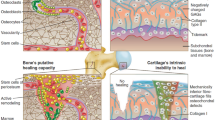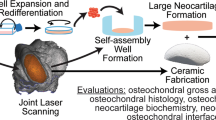Abstract
This study investigates the feasibility of engineering a biohybrid cartilage equivalent (BCE) with the long-term goal of restoring the mechanical integrity and interfacial characteristics of severely damaged cartilage. The BCE depends on the successful adhesion, via mechanical interlocking, of a cartilage layer to a nondegradable composite scaffold or prosthesis. The model scaffold, consisting of a nonwoven mesh bonded to a solid core, was seeded with bovine articular chondrocytes. High molecular weight poly(l-lactic acid), which has a slow degradation time, was used to model the nondegradable polymer. Biochemical and histological analysis demonstrate that the BCE can support the growth of a cartilaginous matrix for at least 6 weeks in culture. Mechanical testing of the BCE showed cartilage adhesion strength increased from 19.27±1.62 to 43.79±3.88 kPa between 35 and 50 days in culture. Nonmechanically interlocked cartilage achieved less than 5% of this adhesion strength. For the first time, atomic force microscopy (AFM) was used to characterize surface topography of tissue-engineered cartilage. Surface roughness of constructs after 8 and 10 weeks ranged from 153 to 171 nm, falling within the range of native cartilage (100–600 nm). This study demonstrates the feasibility of creating a biohybrid cartilage equivalent by mechanically interlocking a cartilaginous layer to an underlying polymeric matrix.






Similar content being viewed by others
REFERENCES
Ahsan, T., and R. L. Sah. Biomechanics of integrative cartilage repair. Osteoarthritis Cartilage 7:29–40, 1999.
Alsberg, E., E. E. Hill, and D. J. Mooney. Craniofacial tissue engineering. Crit. Rev. Oral. Biol. Med. 12:64–75, 2001.
Amstutz, H. C., P. Campbell, N. Kossovsky, and I. C. Clarke. Mechanism and clinical significance of wear debris-induced osteolysis. Clin. Orthop. Relat. Res. 276:7–18, 1992.
Boynton, E. L., M. Henry, J. Morton, and J. P. Waddell. The inflammatory response to particulate wear debris in total hip arthroplasty. Can. J. Surg. 38:507–515, 1995.
Buma, P., N. N. Ramrattan, T. G. van Tienen, and R. P. Veth. Tissue engineering of the meniscus. Biomaterials 25:1523–1532, 2004.
Farndale, R. W., D. J. Buttle, and A. J. Barrett. Improved quantitation and discrimination of sulphated glycosaminoglycans by use of dimethylmethylene blue. Biochim. Biophys. Acta 883:173–177, 1986.
Felix, N. A., and L. E. Paulos. Current status of meniscal transplantation. Knee 10:13–17, 2003.
Freed, L. E., A. P. Hollander, I. Martin, J. R. Barry, R. Langer, and G. Vunjak-Novakovic. Chondrogenesis in a cell-polymer-bioreactor system. Exp. Cell Res. 240:58–65, 1998.
Gao, J., J. E. Dennis, L. A. Solchaga, A. S. Awadallah, V. M. Goldberg, and A. I. Caplan. Tissue-engineered fabrication of an osteochondral composite graft using rat bone marrow-derived mesenchymal stem cells. Tissue Eng. 7:363–371, 2001.
Hailey, J. L., J. Fisher, D. Dowson, S. A. Sampath, R. Johnson, and M. Elloy. A tribological study of a series of retrieved accord knee explants. Med. Eng. Phys. 16:223–228, 1994.
Hansson, U., G. Blunn, and L. Ryd. Histologic reactions to particulate wear debris in different mesenchymal tissues: Studies on the nonreplaced compartment from revised uni-knees. J. Arthroplasty 19:481–487, 2004.
Hills, B. A., and R. W. Crawford. Normal and prosthetic synovial joints are lubricated by surface-active phospholipid: A hypothesis. J. Arthroplasty 18:499–505, 2003.
Hoemann, C. D., J. Sun, V. Chrzanowski, and M. D. Buschmann. A multivalent assay to detect glycosaminoglycan, protein, collagen, RNA, and DNA content in milligram samples of cartilage or hydrogel-based repair cartilage. Anal. Biochem. 300:1–10, 2002.
Hollander, A. P., I. Pidoux, A. Reiner, C. Rorabeck, R. Bourne, and A. R. Poole. Damage to type II collagen in aging and osteoarthritis starts at the articular surface, originates around chondrocytes, and extends into the cartilage with progressive degeneration. J. Clin. Invest. 96:2859–2869, 1995.
Hung, C. T., et al. Anatomically shaped osteochondral constructs for articular cartilage repair. J. Biomech. 36:1853–1864, 2003. [Erratum appears in J. Biomech., 2004 December;37(12):1953. Note: Taki, Erica (corrected to Takai, Erica)].
Jurvelin, J. S., D. J. Muller, M. Wong, D. Studer, A. Engel, and E. B. Hunziker. Surface and subsurface morphology of bovine humeral articular cartilage as assessed by atomic force and transmission electron microscopy. J. Struct. Biol. 117:45–54, 1996.
Keene, D. R., J. T. Oxford, and N. P. Morris. Ultrastructural localization of collagen types II, IX, and XI in the growth plate of human rib and fetal bovine epiphyseal cartilage: Type XI collagen is restricted to thin fibrils. J. Histochem. Cytochem. 43:967–979, 1995.
Kim, Y. J., R. L. Sah, J. Y. Doong, and A. J. Grodzinsky. Fluorometric assay of DNA in cartilage explants using Hoechst 33258. Anal. Biochem. 174:168–176, 1988.
Lewis, P. L., N. T. Brewster, and S. E. Graves. The pathogenesis of bone loss following total knee arthroplasty. Orthop. Clin. N Am. 29:187–197, 1998.
Mercuri, L. G. Considering total temporomandibular joint replacement. Cranio 17:44–48, 1999.
Nizegorodcew, T., G. Gasparini, G. Maccauro, A. Todesca, and E. De Santis. Massive osteolysis induced by high molecular weight polyethylene wear debris. Int. Orthop. 21:14–18, 1997.
Patel, R. V., and J. J. Mao. Microstructural and elastic properties of the extracellular matrices of the superficial zone of neonatal articular cartilage by atomic force microscopy. Front. Biosci. 8:a18–a25, 2003.
Pickard, J. E., J. Fisher, E. Ingham, and J. Egan. Investigation into the effects of proteins and lipids on the frictional properties of articular cartilage. Biomaterials 19:1807–1812, 1998.
Randolph, M. A., K. Anseth, and M. J. Yaremchuk. Tissue engineering of cartilage. Clin. Plast. Surg. 30:519–537, 2003.
Sachlos, E., and J. T. Czernuszka. Making tissue engineering scaffolds work. Review: The application of solid freeform fabrication technology to the production of tissue engineering scaffolds. Eur. Cell Mater. 5:29–39, 2003 [discussion 39–40].
Sah, R. L., Y. J. Kim, J. Y. Doong, A. J. Grodzinsky, A. H. Plaas, and J. D. Sandy. Biosynthetic response of cartilage explants to dynamic compression. J. Orthop. Res. 7:619–636, 1989.
Santavirta, S. Compatibility of the totally replaced hip. Reduction of wear by amorphous diamond coating. Acta Orthop. Scand. Suppl. 74:1–19, 2003.
Schaefer, D., et al. In vitro generation of osteochondral composites. Biomaterials 21:2599–2606, 2000.
Schaefer, D., et al. Tissue-engineered composites for the repair of large osteochondral defects. Arthritis Rheum. 46:2524–2534, 2002.
Schek, R. M., J. M. Taboas, S. J. Segvich, S. J. Hollister, and P. H. Krebsbach. Engineered osteochondral grafts using biphasic composite solid free-form fabricated scaffolds. Tissue Eng. 10:1376–1385, 2004.
Sharma, B. E., and J. H. Elisseeff. Engineering structurally organized cartilage and bone tissues. Ann. Biomed. Eng. 32:148–159, 2004.
Sherwood, J. K., et al. A three-dimensional osteochondral composite scaffold for articular cartilage repair. Biomaterials 23:4739–4751, 2002.
Suciu, A. N., T. Iwatsubo, and M. Matsuda. Theoretical investigation of an artificial joint with micro-pocket-covered component and biphasic cartilage on the opposite articulating surface. J. Biomech. Eng. 125:425–433, 2003.
Tienen, T. G., et al. Prosthetic replacement of the medial meniscus in cadaveric knees—Does the prosthesis mimic the functional behavior of the native meniscus? Am. J. Sports Med. 32:1182–1188, 2004.
Vunjak-Novakovic, G., B. Obradovic, I. Martin, P. M. Bursac, R. Langer, and L. E. Freed. Dynamic cell seeding of polymer scaffolds for cartilage tissue engineering. Biotechnol. Prog. 14:193–202, 1998.
Waldman, S. D., M. D. Grynpas, R. M. Pilliar, and R. A. Kandel. The use of specific chondrocyte populations to modulate the properties of tissue-engineered cartilage. J. Orthop. Res. 21:132–138, 2003.
Woessner, J. F. Jr., The determination of hydroxyproline in tissue and protein samples containing small proportions of this imino acid. Arch. Biochem. Biophys. 93:440–447, 1961.
Wolford, L. M., D. A. Cottrell, and C. H. Henry. Temporomandibular joint reconstruction of the complex patient with the Techmedica custom-made total joint prosthesis. J. Oral Maxillofac. Surg. 52:2–10, 1994.
Wolford, M. Temporomandibular joint devices: Treatment factors and outcomes. Oral Surg. Oral Med. Oral Pathol. Oral Radiol. Endod. 83:143–149, 1997.
ACKNOWLEDGMENTS
This research was supported by the AO Research Foundation. We thank Dr. Gajendra Shekhawat for his help in obtaining AFM images as well as Evanston Hospital and Northwestern Memorial Hospital for histological sectioning and staining expertise. We also thank Swissland Packing Co. for donating the bovine knees.
Author information
Authors and Affiliations
Corresponding author
Rights and permissions
About this article
Cite this article
Romito, L., Ameer, G.A. Mechanical Interlocking of Engineered Cartilage to an Underlying Polymeric Substrate: Towards a Biohybrid Tissue Equivalent. Ann Biomed Eng 34, 737–747 (2006). https://doi.org/10.1007/s10439-006-9089-5
Received:
Accepted:
Published:
Issue Date:
DOI: https://doi.org/10.1007/s10439-006-9089-5




